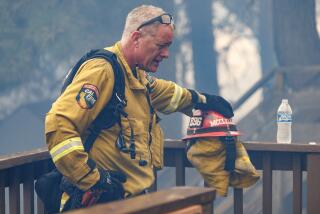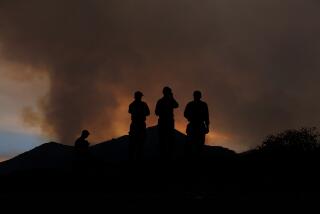Fire command center is like a war room
As the man running the battle against the biggest firestorm in California history, Bob Green struggles to keep his emotions in check as he makes decisions that will determine the fate of entire communities.
“I am a leader, and if I allow my emotions to get involved I will lose focus,” he said Tuesday from the state fire command center in Riverside. “The biggest challenge is trying not to watch television and seeing the devastation taking place, seeing the evacuations and wondering if those people will be OK.”
Over the course of just a few minutes, Green gets a call telling him about a fire racing up San Onofre Peak, near the nuclear power plant. He gets word that Mt. Palomar is burning. Two other fires have erupted at Camp Pendleton.
“Bob, is there any way of getting that DC-10 for a few drops here?” an exasperated commander at the Harris fire in San Diego County asks in a conference call.
Green thinks.
“It’s making drops in Lake Arrowhead,” he says. “We have two DC-7s that could help you out. I can put it together in 30 minutes.”
Other field commanders working at least 15 active fires throughout Southern California call in, begging for the massive DC-10 supertanker -- the biggest firefighting aircraft in the state, capable of dropping 12,000 gallons of fire retardant. Firefighters are exhausted, they tell Green, and it’s affecting their ability to make decisions.
Green, chief of operations for the state fire agency, the California Department of Forestry and Fire Protection, absorbs it all.
He orders air support where he can. Where he can’t, Green offers encouragement. He has little else. Resources are stretched so thin he worries that he will be out of options within 24 hours if new fires keep erupting.
“At that point, there will be a good chance that there will be no more tools to fight this fire,” said Green, 52. “What then? I have never been there before. This will be the worst firestorm California has ever seen.”
Before this, the Southern California wildfires in 2003 were the benchmarks to measure catastrophe. No more.
“In 2003, we had something like 13 major fires over six or seven days,” Green said. “This time we had to ramp up to cover 12 to 15 fires within 72 hours.”
On Sunday, when wildfires tore through Malibu and northern Los Angeles County, coordination among state and local fire agencies was done via conference calls -- with more than 20 people on the line.
Since then, a tightly run fire bureaucracy has taken root at the sprawling Department of Forestry complex on Mulberry Street in Riverside.
The operations center has a war-room buzz: There are map-making rooms, weather rooms and intelligence rooms. The walls are covered with computer screens, and earnest men and women are on phones calling in orders for air support.
Critical updates about each fire are given to the Multi-Agency Coordination System, a group of fire officials representing every city and county in the region, along with the governor’s office, Department of Forestry, U.S. Forest Service and National Weather Service.
On Tuesday, they met almost hourly to decide which fire gets priority. Each fire is assigned a number between 1 and 5 based on its size, the threat to life, the potential to spread and the danger to property. Five is the highest need.
“We look at the density of housing,” said Battalion Chief Jim Hollingsworth, a fire intelligence expert with the Department of Forestry. “We don’t attach a dollar figure to it; we have to be fair.”
Indeed, Hollingsworth sat silently as officials were assigning a number to the Rice fire near Fallbrook, a fire that led to the evacuation of 45,000 people, including his wife and children.
“It’s hard to be detached and objective,” he said. “I had to put my feelings away on the Rice fire knowing my family was affected and my house was just sitting there for anyone to take.”
Each fire is discussed in detail, with incident commanders chiming in from the fire lines via conference call. Fire officials seemed stunned Tuesday as reports of new fires, and more homes lost, kept pouring in.
An incident commander calling in Tuesday morning from the Witch fire said 100 more structures were lost and more than 200,000 acres had been torched.
Another fire was heading up Mt. Palomar, home of the world-famous observatory, one of the largest telescopes in the world.
“You got oak woodland, conifer forests, some of the nastiest terrain in San Diego County,” Forest Service fire commander Ralph Domansky said at the command center. “I tell you we need to put a team on [Mt. Palomar] right now.”
“So is that a 4, or 5?” asked Tom Drayer, deputy chief of the Governor’s Office of Emergency Services.
A woman hovered in front of a white board with a black marker waiting to scrawl a number beside each fire.
Ultimately, Green must decide a course and act decisively. “It’s always a gamble,” he said. “I put all of this information into my blender and then do what my experience tells me to do.”
Green has been a firefighter for 32 years, his father was a firefighter for 36 years, and his daughter is a firefighter. He tries to break tense situations with an easy smile and a wisecrack to avoid what he calls a potential “meltdown.”
He said many people don’t understand why firefighters save some neighborhoods and not others. “It’s often infuriating that we can’t explain to people why we can’t be in every place,” he said. “Aircraft can’t be flown sometimes because of turbulence; firefighters can’t go into a ravine because it might be dangerous. No house or tree is worth losing a life over. And my No. 1 priority is life.”
Times staff writers Steve Chawkins and Stuart Pfeifer contributed to this report.
More to Read
Sign up for Essential California
The most important California stories and recommendations in your inbox every morning.
You may occasionally receive promotional content from the Los Angeles Times.









